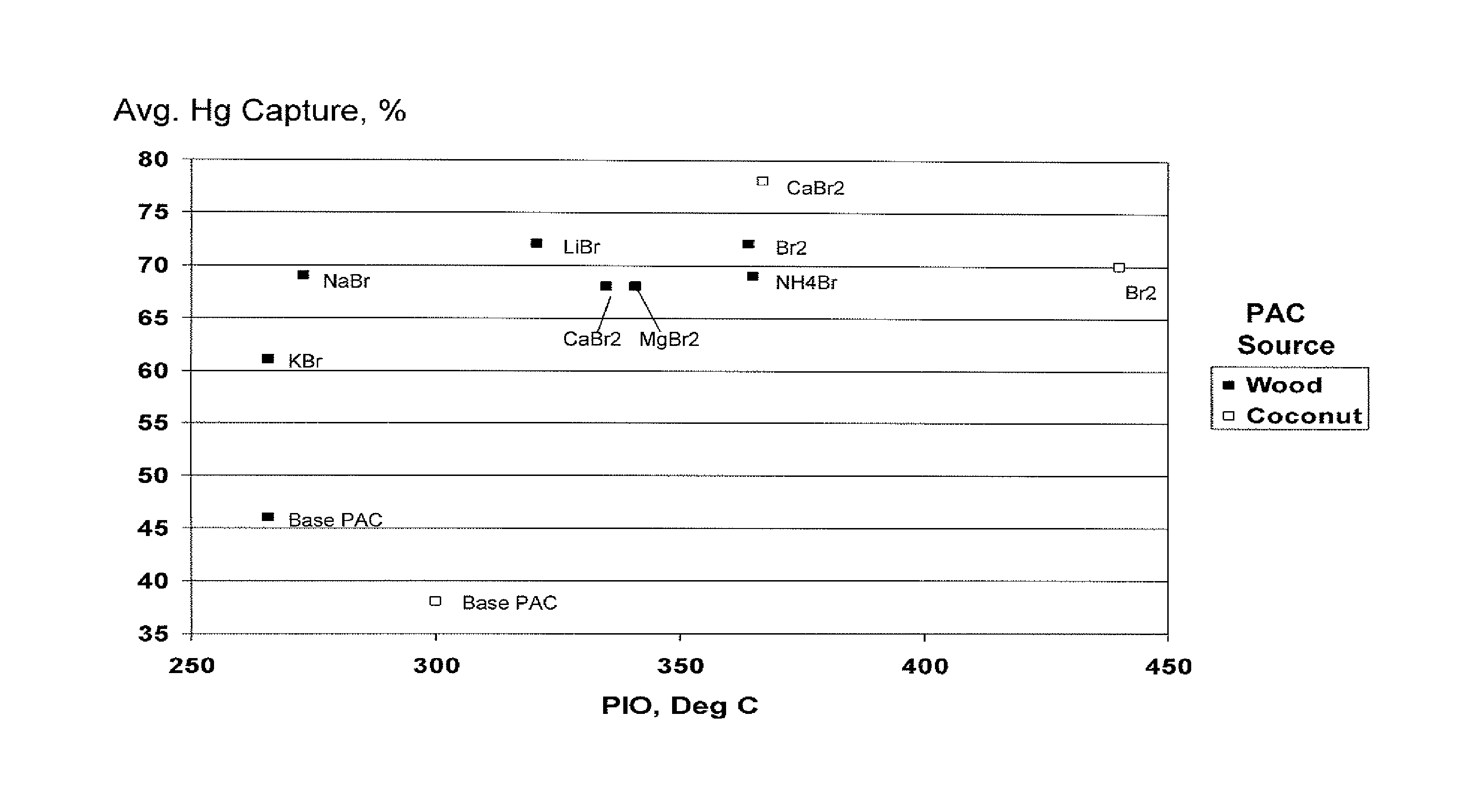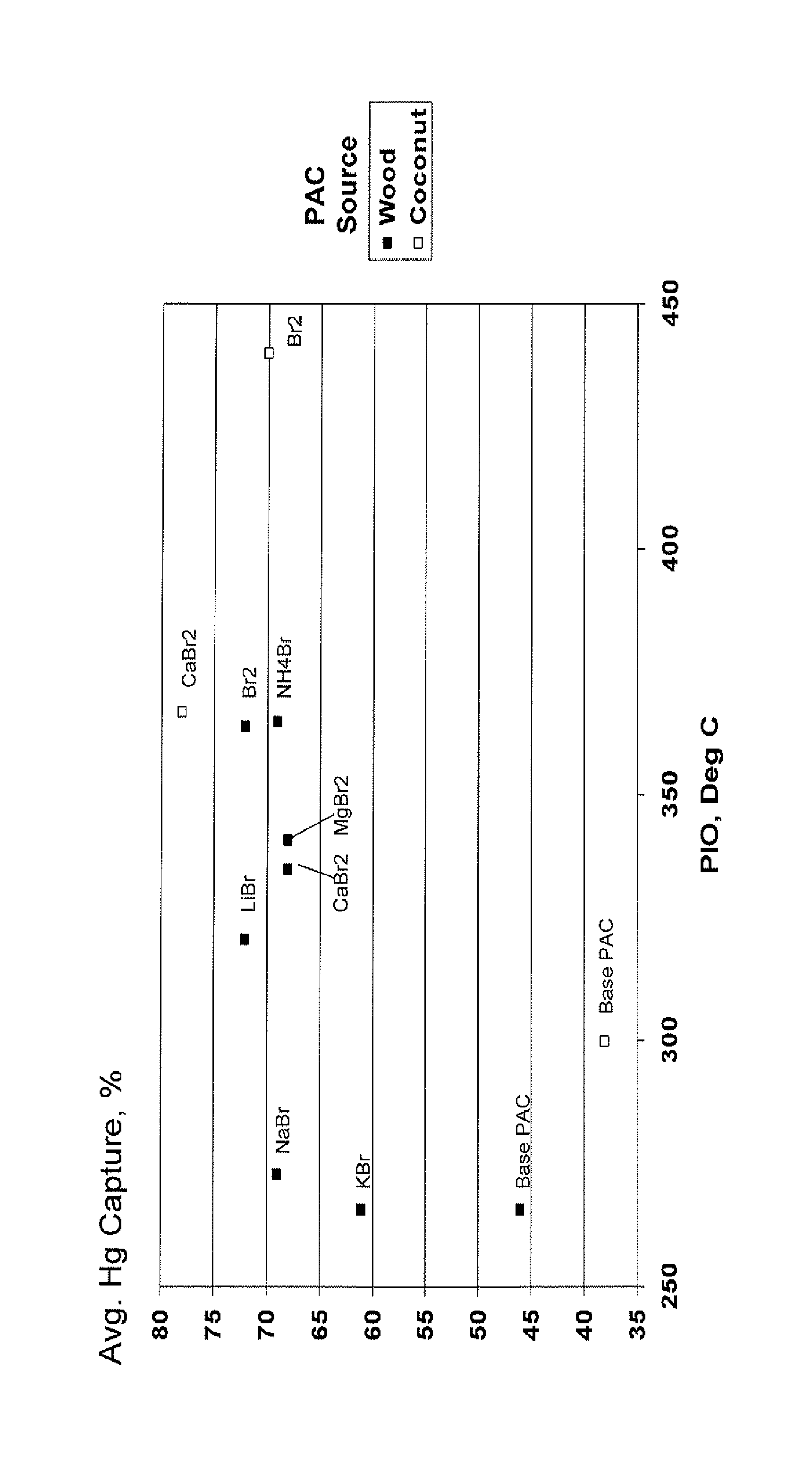Use of bromide-containing inorganic salt for reducing mercury emissions from combustion gas streams
a technology of inorganic salt and combustion gas, which is applied in the direction of dispersed particle separation, other chemical processes, separation processes, etc., can solve the problems of large amount of bromine remaining in the flue gas, corroding scrubber systems, and bromine formation, so as to reduce mercury emissions, reduce mercury emissions, and reduce mercury emissions
- Summary
- Abstract
- Description
- Claims
- Application Information
AI Technical Summary
Benefits of technology
Problems solved by technology
Method used
Image
Examples
example 1
[0028]A wood-derived PAC (powdered activated carbon) (prepared by the thermal activation process) utilized in these examples was analyzed by DSC-TGA. The point of initial oxidation (PIO) was 266 deg C.
[0029]Preparation Procedure I—
[0030]A sample of the wood-derived PAC was brominated according to the process disclosed in U.S. Pat. No. 6,953,494. Elemental analysis indicated a PAC bromine content of 5 wt %.
[0031]Preparation Procedure II—
[0032]A series of treated PACs were prepared by slurrying the wood-derived PAC with various sources of ionic bromide and then drying by placing in a recirculating oven at 60-80 deg C. The treated PAC bromine value was 5 wt %.
[0033]The performance of these treated PACs was compared. Performance tests included DSC, which measures of the thermal properties of the activated carbon.
[0034]The following data compares the thermal stability of the various PACs as determined by DSC as well as average mercury capture capabilities (Hg, %). The point of initial en...
example 2
[0036]A coconut shell-derived PAC (powdered activated carbon) (prepared by the thermal activation process) utilized in these examples was analyzed by DSC-TGA. The point of initial oxidation (PIO) was 300 deg C.
[0037]Preparation Procedure I—
[0038]A sample of the coconut shell-derived PAC was brominated according to the process disclosed in U.S. Pat. No. 6,953,494. Elemental analysis indicated a PAC bromine content of 5 wt %.
[0039]Preparation Procedure II—
[0040]A series of treated PACs were prepared by slurrying the coconut shell-derived PAC with various sources of ionic bromide and then drying by placing in a recirculating oven at 60-80 deg C. The treated PAC bromine value was 5 wt %.
[0041]The performance of these treated PACs was compared. Performance tests included DSC, which measures of the thermal properties of the activated carbon.
[0042]The following data compares the thermal stability of the various PACs as determined by DSC as well as average mercury capture capabilities (Hg, ...
PUM
| Property | Measurement | Unit |
|---|---|---|
| temperature | aaaaa | aaaaa |
| temperatures | aaaaa | aaaaa |
| temperatures | aaaaa | aaaaa |
Abstract
Description
Claims
Application Information
 Login to View More
Login to View More - R&D
- Intellectual Property
- Life Sciences
- Materials
- Tech Scout
- Unparalleled Data Quality
- Higher Quality Content
- 60% Fewer Hallucinations
Browse by: Latest US Patents, China's latest patents, Technical Efficacy Thesaurus, Application Domain, Technology Topic, Popular Technical Reports.
© 2025 PatSnap. All rights reserved.Legal|Privacy policy|Modern Slavery Act Transparency Statement|Sitemap|About US| Contact US: help@patsnap.com


